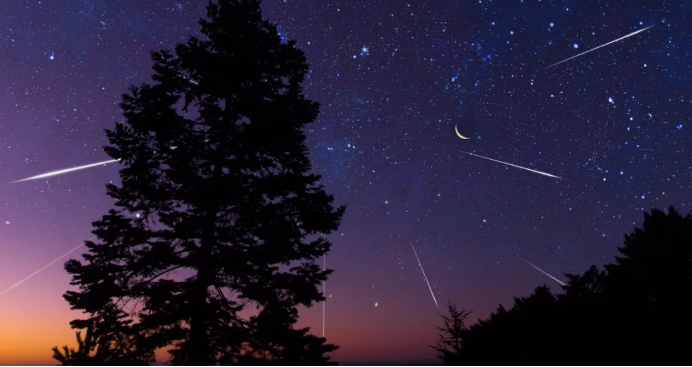
Get ready for a dazzling sky show! The Lyrid meteor (流星) shower, one of nature’s oldest light displays, will light up the Northern Hemisphere this April. In China, the best time to watch is from the evening of April 22 to the early hours of April 23. This year, Beijing stargazers have perfect conditions: the moon will be a thin crescent (only 27% bright) and won’t rise until 3 AM on April 23, ensuring dark skies for better visibility!
Meteor showers happen when Earth passes through trails of dust left by comets or asteroids. These tiny rocks, some as small as grains of sand, burn up in Earth’s atmosphere, creating bright streaks called “shooting stars”. The Lyrids come from Comet Thatcher, discovered in 1861. Chinese astronomers first recorded this meteor shower over 2,700 years ago! What you see isn’t the rock itself but the glowing hot air around it — some trails can be 10 miles wide!
Active from April 14 to 30, the Lyrids peak around April 22. For most areas in China, the best viewing starts after 10 PM when the meteor “radiant point” (near the bright star Vega) rises higher in the sky. You don’t need a telescope — just your eyes! Follow these tips:
1) Escape city lights: Head to countryside areas, parks, or mountains where skies are darker.
2) Be patient: Let your eyes adjust to darkness for 20 minutes, and avoid phone screens.
3) Dress warmly: Nights in April can still be chilly.
4) Look everywhere: Meteors can appear anywhere in the sky, not just near the Lyra constellation (星座).
While the Lyrids aren’t the busiest shower (about 18 meteors per hour), they often produce bright fireballs. Every 60 years, they surprise us with up to 100 meteors hourly! The next big show is predicted for 2042. Want to capture the moments? Use a camera on a tripod with manual settings, aim it at open sky, and wait — meteors are fast but unforgettable!
Mark your calendar, find a dark spot, and look up — you might just catch a piece of cosmic magic!
原创编写 版权所有 侵权必究! 每日更新 个性化阅读 英语飙升!
1.1.What makes Beijing a good location for observing the Lyrids this year?
A Clear weather.
B Bright moonlight.
C A dark sky.
D High visibility.
解析:选C。C 细节理解题。根据第一段中的“the moon will be a thin crescent (only 27% bright) and won’t rise until 3 AM on April 23, ensuring dark skies for better visibility”可知,北京观测条件优越的原因是月亮为残月(仅27%亮度)且在23日凌晨3点后才升起,确保了黑暗的天空。故选C。
2.2.The term “shooting stars” refers to ______.
A real stars moving fast
B small space rocks burning up
C bright stars in Lyra
D satellite lights glowing
解析:选B。B 词意指代题。根据第二段内容及“What you see isn’t the rock itself but the glowing hot air around it”可知,太阳系内的彗星或小行星释放出的大量碎片,在进入地球大气层时高速运动与大气摩擦产生的燃烧就形成了流星雨。即shooting stars指的是彗星或小行星的碎片在大气层中燃烧的现象。故选B。
3.3.What can we conclude from the viewing tips?
A Telescopes are necessary.
B City areas are ideal for viewing.
C Quick sight matters.
D Warm clothing is needed.
解析:选D。D 细节理解题。根据第三段中的“Dress warmly: Nights in April can still be chilly”可知,观看时需要穿暖和的衣服,因为四月的晚上依然比较冷。故选D。
4.4.What is the main purpose of the text?
A To introduce the history of the Lyrids.
B To give tips on watching the Lyrids.
C To encourage people to watch the Lyrids.
D To explain how meteor showers happen.
解析:选C。C 推理判断题。文章介绍了天琴座流星雨的时间、成因、观看建议等,结尾“Mark your calendar, find a dark spot, and look up—you might just catch a piece of cosmic magic!”表明作者鼓励人们去观看流星雨。故选C。
